The MSI Titan GT77 Review: Desktop-Class Core i9-12900HX Tested
by Brett Howse on September 1, 2022 10:00 AM EST- Posted in
- Laptops
- Intel
- MSI
- Alder Lake
- Alder Lake-HX
Platform Power and Multitasking
With Intel’s Alder Lake platform being a hybrid design, it promises better multitasking performance thanks to the inclusion of the many E-Cores on top of the 8 P-Cores already present. The E-cores offer Skylake-like performance in a small, dense design (4 E-cores fit in the space of 1 P-core), allowing Intel to pack in 8 of them while still keeping die sizes (and manufacturing costs) reasonable.
With the MSI Titan GT77 and Intel’s new HX series of processors, multitasking is a key selling feature. Adding an additional two P-Cores increases the ability to perform multiple tasks – particularly those that aren't quite embarrassingly parallel and would do best with more P-cores – while the higher power levels allow the cores to run at a higher frequency to get the work done quicker.
An over seven pound laptop is really all about performance first, and in order to achieve performance you also need adequate cooling or the CPU will throttle itself due to its significant heat output. MSI’s Titan GT77 has an impressive cooling solution which is rated for up to 250 Watts of heat dissipation. Depending on workload, that will be up to 175 Watts for the RTX graphics, and an additional 75 Watts for the processor sustained. But thanks to dynamic boost, if the GPU is not using all of its headroom the CPU can use that extra power.
As is typical of MSI they offer three user-selectable power modes, as well as a Smart AI mode which will automatically change the mode. Extreme Performance offers the highest power draw, and comes with the highest noise levels. Balanced drops the power a bit to keep noise levels in check, and the Silent Mode means that the fans will be inaudible.
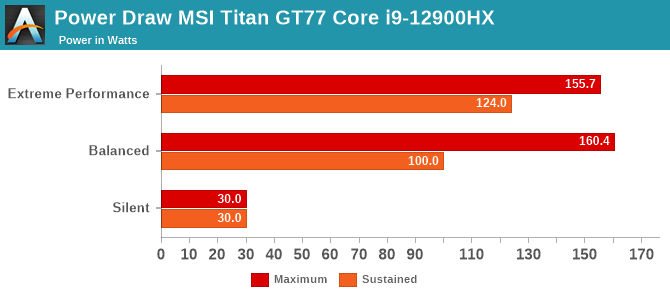
In Extreme Performance mode there is almost a ridiculous amount of power available to the processor. The PL2 maximum is right at the 157 Watt maximum Intel allows for the HX processor, but the PL1 sustained level is a staggering 124 Watts. For a notebook computer, that is really unheard of. What is very impressive though is that despite this power draw, at load in Extreme Performance mode the sound pressure level (SPL) measured one inch over the trackpad never exceeded 58.3 dB(A). That is loud, but if you need the maximum out of the system the four-fan cooling solution can get the job done but it needs to work at it.
Turning things down a bit to the balanced mode means that you get the same PL2 level of 157 Watts (we actually measured just over 160 Watts) but the PL1 level is a more mundane 100 Watts. For comparison, the MSI Raider GE76 with a Core i9-12900HK processor in balanced mode peaks at 105 Watts and runs sustained at 75 Watts. The sustained level in balanced mode here is pretty much the same as the peak on the Raider GE76. That’s a lot of power. This is the selling point of the HX processor. In balanced mode, the SPL was a much more reasonable 52.3 dB(A) which is still noisy but much more reasonable than Extreme Performance.
MSI also offers a Silent mode which caps the processor at just 30 Watts for both PL1 and PL2. Noise is minimized, but at those power levels performance takes a big hit too. In balanced mode the fans don’t make a lot of noise unless you are really working the system, so unless you absolutely can’t have any fan noise, this mode should be avoided.
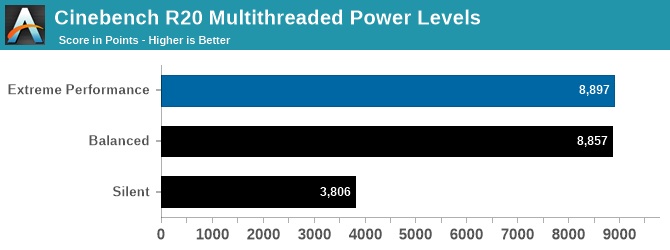
To see how the different power settings impact system performance, Cinebench R20 was run in all three modes. Although this is not a very long test on such a powerful system, it does reinforce that when it comes to CPU performance, the last few percentage points of performance come at the highest cost. Despite the Extreme Performance mode having a 24% higher power level, in Cinebench that only equates to a 0.45% performance increase. If your workload was a longer workload it would likely be higher than that, but thanks to power being an exponential equation it will never be a one to one gain.
The Silent results are very low thanks to the 30 Watt cap resulting in a result that is 57% lower than the Balanced Mode, albeit at 70% lower sustained power.
Multitasking
Replicating the multitasking workloads from the Alder Lake H review, again we will test out how the MSI Titan GT77 handles running multiple workloads at the same time. To give an analytical look at the multitasking abilities of several laptops, a test was created to simulate a workload where an intensive task was shuffled to the background, and then several apps were run in the foreground and the performance measured. To achieve this, Handbrake was set to transcode a long 1080p video to 720p using the x264 software encoder. Then, that task was shuffled to the background, and both PCMark 10’s Modern Office test suite was run, as well as Cinebench R20. Performance was measured for PCMark 10, Cinebench, and Handbrake to get a feel for how the system was handling the intense load.
The results are not so much about the absolute values but what the percentage change was compared to an unloaded result. Let’s dive in.
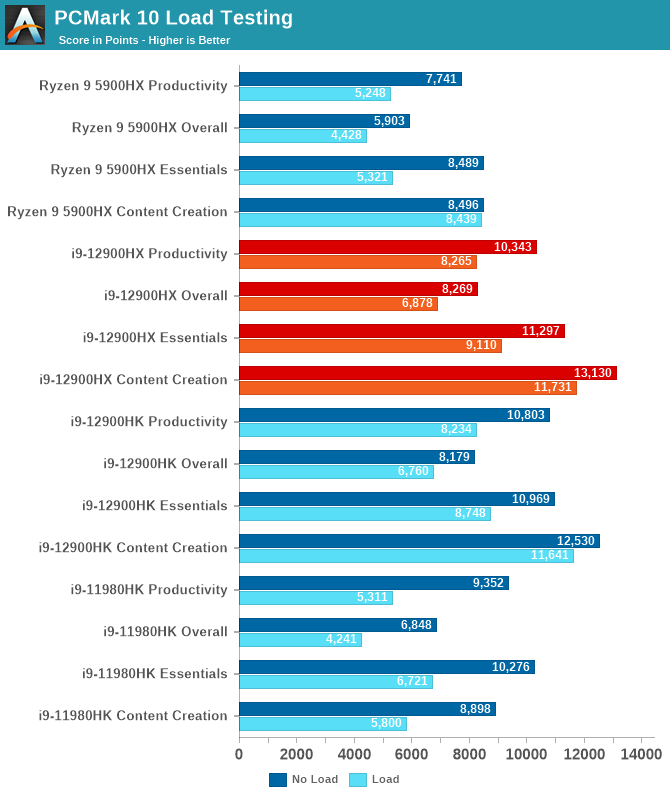
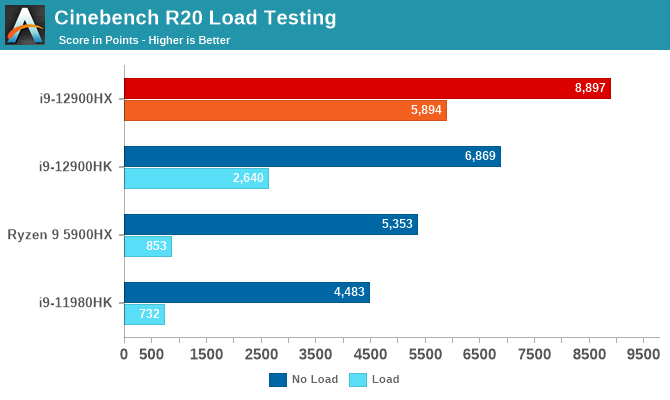
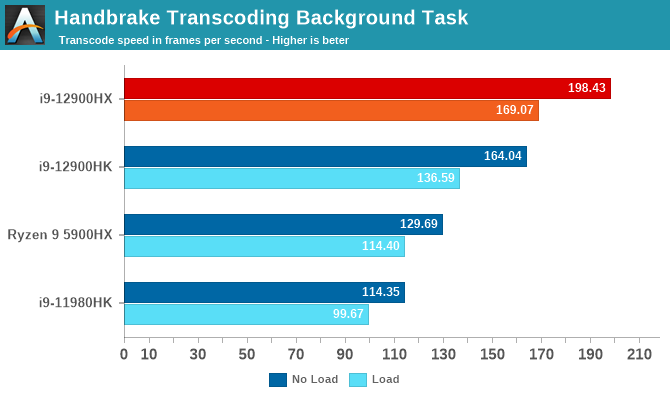
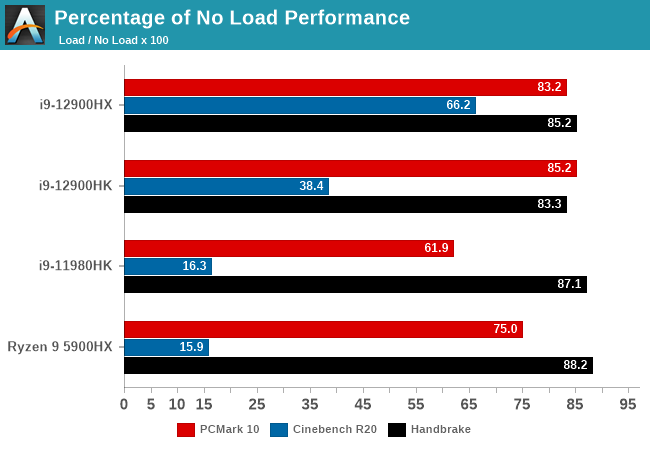
Although the actual scores are included as well for reference, the key graph is Percentage of No Load Performance. On the PCMark 10 result, the i9-12900HX was able to achieve 83.2% of the no-load result with handbrake running a software transcode in the background. That is right in-line with the other Alder Lake processor. It is a significant increase over Tiger Lake (Core i9-11980HK) and Ryzen 5000 (Ryzen 9 5900HX).
The most impressive change was Cinebench R20 though. The new HX processor was able to achieve 66.2% of the no-load result which is significantly higher than the HK CPU. As this was running in Extreme Performance mode, the extra headroom in PL1 as well as the additional two P-Cores definitely helped out here.
The background task for the HX processor, which was Handbrake doing a 1080p to 720p transcode, was again in-line with the HK processor. Both of the Alder Lake processors were unable to achieve as high of a percentage here compared to Tiger Lake and Ryzen, but both show they offer far more foreground performance at the same time. It is an impressive result.
The big win is usability. With Alder Lake, even with a heavy workload running in the background, the system stays responsive and lets you continue working. Looking at absolute performance is also impressive. The HX system was faster doing the Handbrake transcode while loaded than the HK system was able to attain unloaded. There is just a lot of performance on-tap here and it really opens the MSI Titan GT77 up to even more workloads.












25 Comments
View All Comments
Otritus - Sunday, September 4, 2022 - link
It’s a pretty decent benchmark to measure relative perform between processors, but almost no software uses the engine making it not “real world”. Cinebench is not a very good predictor for gaming performance because it scales poorly with additional cache. It is a decent predictor of productivity differences since it is a rendering workload, but you can always use “real world” tests like blender or adobe. I wouldn’t say it’s terrible — as it can provide decent insight into a processor with a single benchmark — but it provides no insight into workloads that a micro architecture can be very good at.bogda - Friday, September 2, 2022 - link
I expected at least several pictures of laptop internals. Considering the type of laptop tested, this would probably be interesting for many anandtech readers.Ryan Smith - Friday, September 2, 2022 - link
Unfortunately, we are typically prohibited from disassembling laptops these days. The manufacturers like to get them back intact.bogda - Friday, September 2, 2022 - link
I am sure anandtech with its reputation and history can get a permission to open and close desktop replacement laptop from manufacturer without problems. Peek inside it the least you readers expect.PeachNCream - Saturday, September 3, 2022 - link
No they really can't do that if they expect to get more review samples in the future. Reviewer sites of yore used to buy their hardware off the shelf, but in a age where landing benchmarks first is going to generate competitive page views, reviewers can't realistically wait until a laptop/phone/desktop lands on the shelves (especially now with supply problems, scalpers, and gray market reseller markups) so this is the world we live in. If you want internals, you just have to wait until someone rips one apart and that probably won't be very early in the hardware life cycle.IBM760XL - Friday, September 2, 2022 - link
Does AnandTech typically return laptops not-intact? :)It's a fair request, one of the things I look for in laptops is upgradeability. Being able to add more RAM or storage or perhaps upgrading the WiFi card down the road is an important consideration.
Although as an owner of an MSI, I'm well aware of their "opening this area voids the warranty" sticker. Not that it's ever stopped me, but they seem to be more of a stickler for that than most.
sheh - Friday, September 2, 2022 - link
Why are bad keyboard layouts the norm?Plenty of unused space horizontally (and also vertically).
meacupla - Friday, September 2, 2022 - link
What are you talking about? The keyboard layout is fineThe sides are filled with speakers, the rear is filled with cooling, and the front has a giant track pad.
IBM760XL - Friday, September 2, 2022 - link
My guess is sheh prefers full-width NumPads?Personally I have fewer complaints than for most laptop keyboards. It doesn't have half-height arrow keys, which is my top requirement (although it's not quite full-size, let's give it a B grade). The Cherry MX probably hash decent key feel/travel, which is also lacking on some laptops.
I'd personally slightly prefer dedicated page up/down/home/end buttons, versus the NumPad-off variant, but that's a small quibble and from someone who's learned to touch-type numbers quickly without a NumPad, and who usually only uses NumPads for directional movement in grid-based games.
So, yeah, overall I think they did a lot better job on the keyboard than most manufacturers do these days...
logoffon - Saturday, September 3, 2022 - link
Given that MSI is kind of a king of that, I'm honestly not really surprised. But they did get to new low with this layout.